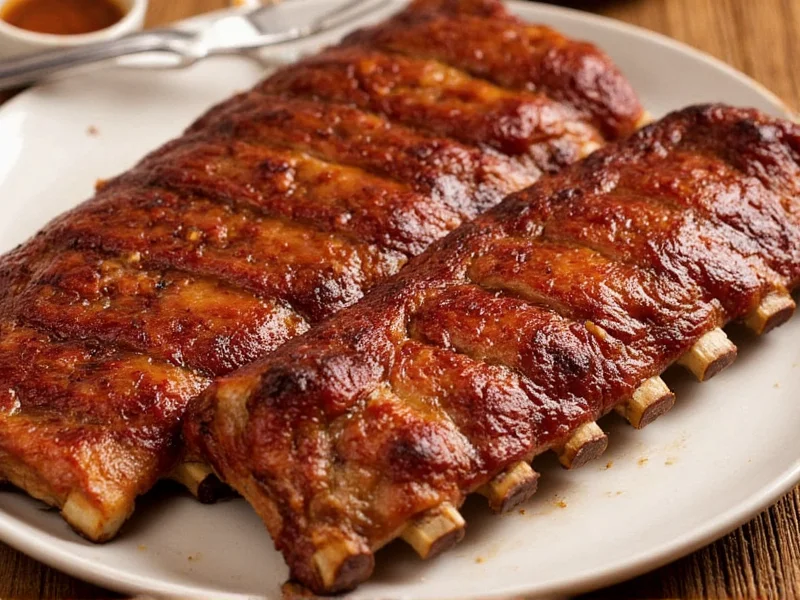Understanding the difference between baby back and spare ribs is essential for any barbecue enthusiast or home cook looking to create the perfect meal. While both cuts deliver that beloved rib experience, their anatomical origins on the pig create significant variations that impact everything from preparation to final presentation.
Anatomical Origins: Where Each Cut Comes From
Baby back ribs, technically known as loin back ribs, are cut from where the rib meets the spine after the loin is removed. They're curved and sit above the hog's spare ribs, closer to the backbone. These ribs are typically 3-6 inches long and come in racks of 10-13 bones.
Spare ribs, also called side ribs or belly ribs, come from the lower portion of the pig, specifically the belly area just below the baby backs. This cut includes 11-13 bones that are flatter and longer (about 6-8 inches) than baby backs. The St. Louis cut—a popular variation—is simply spare ribs with the sternum bone and excess fat trimmed away for a more uniform shape.
| Characteristic | Baby Back Ribs | Spare Ribs |
|---|---|---|
| Location on Pig | Top back near loin | Belly area below baby backs |
| Size | Shorter (3-6 inches), curved | Longer (6-8 inches), flatter |
| Meat-to-Bone Ratio | Higher meat content | More bone, less meat |
| Fat Content | Leaner | Fattier with more marbling |
| Connective Tissue | Less | More (especially in membrane) |
| Average Price | 20-30% more expensive | More economical |
Flavor and Texture Comparison
The taste difference between baby back and spare ribs stems primarily from their fat content and marbling. Baby backs' leaner composition results in a milder, more delicate flavor that readily absorbs rubs and sauces. Their texture is consistently tender with less chew, making them ideal for those who prefer meat that falls easily from the bone.
Spare ribs deliver a richer, porkier flavor due to their higher fat content and marbling. When cooked properly, this fat renders down, basting the meat from within and creating that signature barbecue succulence. The additional connective tissue requires longer cooking but transforms into gelatin, yielding a more substantial, meaty texture with satisfying chew.
Cooking Considerations for Each Cut
Mastering the cooking baby back ribs vs spare ribs process requires understanding their different needs. Baby backs typically cook faster—about 3-4 hours at 225°F—due to their smaller size and lower fat content. Their leanness means they can dry out more easily if overcooked, so precise temperature control is essential.
Spare ribs demand longer cooking times—usually 4-6 hours at the same temperature—to properly render their fat and break down connective tissues. Many pitmasters use the 3-2-1 method (3 hours unwrapped, 2 hours wrapped in foil with liquid, 1 hour unwrapped to set the bark) specifically for spares. The membrane on the bone side of spare ribs should be removed for better smoke penetration and tenderness.
Price and Availability Factors
When considering price comparison baby back ribs and spare ribs, baby backs typically cost 20-30% more due to their premium status, leaner profile, and higher meat-to-bone ratio. They're often the default "ribs" option at restaurants and are more consistently available year-round.
Spare ribs represent better value for those seeking intense flavor and don't mind the extra cooking time. They're more seasonal, often appearing in greater abundance during fall and winter months. The St. Louis cut of spare ribs commands a slight premium over untrimmed spares due to the additional butchering work.
Choosing the Right Rib for Your Occasion
Selecting between these cuts depends on your specific needs. For a which ribs are better baby back or spare decision, consider these scenarios:
- Choose baby backs when: You want faster cooking, prefer leaner meat, need a more elegant presentation, or are cooking for guests who prefer tender, fall-off-the-bone texture
- Choose spare ribs when: Maximum flavor is your priority, you have time for longer cooking, want more economical option, or desire that authentic, hearty barbecue experience
Avoiding Common Preparation Mistakes
Both cuts have specific pitfalls to avoid. With baby backs, the most common error is overcooking, which causes the meat to dry out due to lower fat content. Many home cooks also neglect to remove the thin membrane on the bone side, which can create an unpleasant chewy texture.
For spare ribs, insufficient cooking time is the primary mistake—undercooked spares remain tough and chewy. Another frequent error is not properly trimming the hard breastbone section, which never becomes tender. Some cooks also fail to account for the uneven thickness of spare ribs, leading to some sections overcooking while others remain underdone.
Final Considerations for Rib Enthusiasts
Understanding the difference between baby back and spare ribs empowers you to make informed choices based on your cooking timeline, flavor preferences, and budget. While baby backs offer convenience and tenderness, spare ribs deliver that deep, rich barbecue experience many enthusiasts seek. Some pitmasters even combine both cuts in competition entries—using baby backs for their presentation qualities and spares for their robust flavor profile.











 浙公网安备
33010002000092号
浙公网安备
33010002000092号 浙B2-20120091-4
浙B2-20120091-4